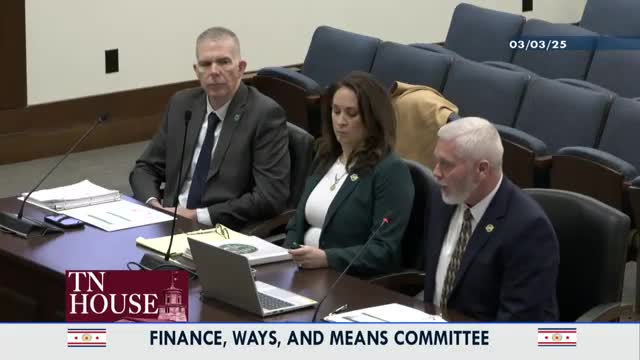Tennessee Wildlife Agency faces funding challenges and seeks increased hunting access
March 03, 2025 | Finance, Ways, and Means, House of Representatives, Committees, Legislative, Tennessee
This article was created by AI summarizing key points discussed. AI makes mistakes, so for full details and context, please refer to the video of the full meeting. Please report any errors so we can fix them. Report an error »

In a gathering marked by urgency and concern, the Tennessee House Finance, Ways, and Means Committee convened on March 3, 2025, to address the pressing issues surrounding the funding model of the Tennessee Wildlife Resources Agency (TWRA). The atmosphere was charged as officials outlined the challenges facing wildlife conservation efforts in the state, primarily stemming from stagnant revenue sources.
The meeting opened with a heartfelt acknowledgment of hunters and anglers, whose license purchases have historically supported conservation efforts. However, as the agency's representative noted, the reliance on hunting and fishing license sales is no longer sustainable. "Our current funding model is just not working," he stated, highlighting a nationwide trend of declining participation in these activities. With license sales stagnant and the last fee increase occurring in 2015, the agency finds itself grappling with a budget that has fallen behind the cost of living.
Federal funding, which constitutes a significant portion of the agency's revenue, was also discussed. Approximately 29% of the TWRA's budget comes from federal apportionments, derived from excise taxes on firearms and ammunition. These funds are crucial for various projects, including grants to partner organizations for research and conservation initiatives. Yet, the agency faces a daunting task of spending these funds effectively before reimbursement can occur.
One of the most pressing challenges highlighted was access to land for hunting and fishing. The representative emphasized that many individuals express frustration over limited access to hunting properties and waterways. With agricultural land disappearing at an alarming rate—about 10 acres every hour—opportunities for hunting are dwindling. Rising land prices further exacerbate the issue, making it increasingly difficult for working-class individuals to secure hunting leases or purchase land.
In response to these challenges, the TWRA is actively pursuing initiatives aimed at recruitment and retention of hunters, known as the R3 movement. This national effort seeks to engage new participants while retaining existing ones. The agency reported that it reached approximately 17,000 participants through various events this year, showcasing a commitment to fostering a new generation of outdoor enthusiasts.
The meeting also touched on the agency's recent acquisition of 66,000 acres of land, primarily for conservation purposes. However, the focus remains on smaller tracts that can be effectively managed, as larger acquisitions pose logistical challenges.
As the session concluded, the urgency of the situation was palpable. The TWRA is at a crossroads, needing to adapt its funding model and address the barriers to access that threaten the future of hunting and fishing in Tennessee. With a fee increase proposal on the horizon, effective solutions will be crucial in ensuring the sustainability of wildlife resources and the preservation of the state's rich natural heritage.
The meeting opened with a heartfelt acknowledgment of hunters and anglers, whose license purchases have historically supported conservation efforts. However, as the agency's representative noted, the reliance on hunting and fishing license sales is no longer sustainable. "Our current funding model is just not working," he stated, highlighting a nationwide trend of declining participation in these activities. With license sales stagnant and the last fee increase occurring in 2015, the agency finds itself grappling with a budget that has fallen behind the cost of living.
Federal funding, which constitutes a significant portion of the agency's revenue, was also discussed. Approximately 29% of the TWRA's budget comes from federal apportionments, derived from excise taxes on firearms and ammunition. These funds are crucial for various projects, including grants to partner organizations for research and conservation initiatives. Yet, the agency faces a daunting task of spending these funds effectively before reimbursement can occur.
One of the most pressing challenges highlighted was access to land for hunting and fishing. The representative emphasized that many individuals express frustration over limited access to hunting properties and waterways. With agricultural land disappearing at an alarming rate—about 10 acres every hour—opportunities for hunting are dwindling. Rising land prices further exacerbate the issue, making it increasingly difficult for working-class individuals to secure hunting leases or purchase land.
In response to these challenges, the TWRA is actively pursuing initiatives aimed at recruitment and retention of hunters, known as the R3 movement. This national effort seeks to engage new participants while retaining existing ones. The agency reported that it reached approximately 17,000 participants through various events this year, showcasing a commitment to fostering a new generation of outdoor enthusiasts.
The meeting also touched on the agency's recent acquisition of 66,000 acres of land, primarily for conservation purposes. However, the focus remains on smaller tracts that can be effectively managed, as larger acquisitions pose logistical challenges.
As the session concluded, the urgency of the situation was palpable. The TWRA is at a crossroads, needing to adapt its funding model and address the barriers to access that threaten the future of hunting and fishing in Tennessee. With a fee increase proposal on the horizon, effective solutions will be crucial in ensuring the sustainability of wildlife resources and the preservation of the state's rich natural heritage.
View full meeting
This article is based on a recent meeting—watch the full video and explore the complete transcript for deeper insights into the discussion.
View full meeting
